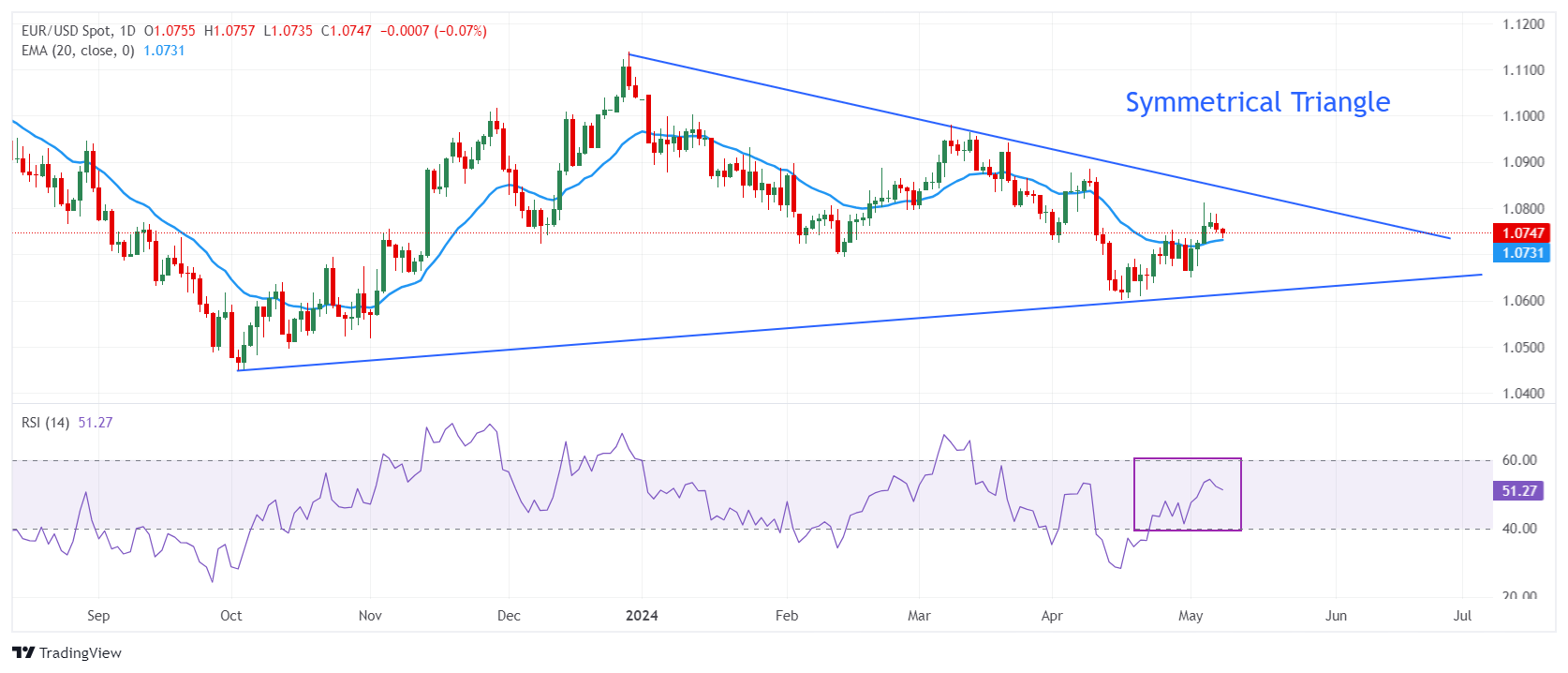EUR/USD falls slightly amid risks of prolonged Fed-ECB policy divergence

- EUR/USD comes down slightly to 1.0740 as the US Dollar rises amid a light US economic calendar.
- The ECB is expected to opt for cutting interest rates in June.
- Fed’s Kashkari sees no rate cuts this year due to the strong housing market.
EUR/USD is slightly down to 1.0740 in Wednesday’s European session. The major currency pair drops as the US Dollar rises as comments from central bank officials become the main market movers in the absence of top-tier economic data in the Eurozone and the United States.
Investors underpinned the Euro against the US Dollar in the past few trading sessions as speculation for the Federal Reserve (Fed) pivoting to interest-rate cuts strengthened due to weak US economic data. However, the Euro struggles to hold strength amid firm expectations that the European Central Bank (ECB) will cut rates before the Fed.
Financial markets see the ECB starting to cut interest rates from the June meeting. Price pressures in the Eurozone economy are on course to return to the 2% target, and service inflation started softening after remaining steady at 4.0% for straight five months. A slew of ECB policymakers remain comfortable with interest rates coming down from June, provided there are no surprises. Also, the ECB is expected to cut interest rates three times this year, more than the Fed, which will widen the policy divergence between both central banks.
Daily digest market movers: EUR/USD drops as US Dollar extends recovery
- EUR/USD comes under pressure as the US Dollar rebounds, recovering losses inspired by the Federal Reserve’s less hawkish guidance on interest rates than feared and weak US economic data for April. The US Dollar Index (DXY), which tracks the Greenback’s value against six major currencies, advances to 105.60.
- Last week, Fed Chair Jerome Powell said after the monetary policy meeting that further policy tightening is not in the picture. His comments signalled that he continues to lean towards rate cuts this year. However, Powell acknowledged that progress in the disinflation process appears to be stalling.
- The US Nonfarm Payrolls (NFP) report for April showed that fewer jobs were added in April, and the Unemployment Rate rose to 3.9%. Average Earnings slowed more than expected, which pointed to a softening inflation outlook. The Services PMI fell below the 50.0 threshold, which separates expansion from contraction. The service sector’s output fell to 49.4, missing estimates of 52.0 by a wide margin.
- Contrary to Powell’s intent of remaining hopeful for rate cuts, Minneapolis Federal Reserve (Fed) Bank President Neel Kashkari said on Tuesday that he sees interest rates remaining at their current levels for the entire year. Stalling progress in the disinflation process due to the strong housing market turned Kashkari hawkish on the interest rate outlook.
- The impact of Kashkari’s hawkish guidance on interest rates on speculation for the Fed to start reducing interest rates from the September meeting is expected to remain subdued as he is a non-voting member until 2026. The CME FedWatch tool shows that there is a 65% chance for interest rates to reduce from their current levels in September. The probability of the Fed lowering rates in September has increased from the 53% recorded a week ago.
Technical Analysis: EUR/USD remains offered near 1.0800
EUR/USD falls after failing to recapture the round-level resistance of 1.0800. The shared currency pair exhibits a sharp volatility contraction due to a Symmetrical Triangle formation on the daily time frame. The upward-sloping border of the triangle pattern is plotted from the October 3 low at 1.0448, and the downward-sloping border is placed from the December 28 high around 1.1140.
The 14-period Relative Strength Index (RSI) oscillates inside the 40.00-60.00 range, suggesting indecisiveness among market participants.
The asset trades above the 20-day Exponential Moving Average (EMA) near 1.0723, suggesting that the near-term outlook is bullish.
ECB FAQs
The European Central Bank (ECB) in Frankfurt, Germany, is the reserve bank for the Eurozone. The ECB sets interest rates and manages monetary policy for the region. The ECB primary mandate is to maintain price stability, which means keeping inflation at around 2%. Its primary tool for achieving this is by raising or lowering interest rates. Relatively high interest rates will usually result in a stronger Euro and vice versa. The ECB Governing Council makes monetary policy decisions at meetings held eight times a year. Decisions are made by heads of the Eurozone national banks and six permanent members, including the President of the ECB, Christine Lagarde.
In extreme situations, the European Central Bank can enact a policy tool called Quantitative Easing. QE is the process by which the ECB prints Euros and uses them to buy assets – usually government or corporate bonds – from banks and other financial institutions. QE usually results in a weaker Euro. QE is a last resort when simply lowering interest rates is unlikely to achieve the objective of price stability. The ECB used it during the Great Financial Crisis in 2009-11, in 2015 when inflation remained stubbornly low, as well as during the covid pandemic.
Quantitative tightening (QT) is the reverse of QE. It is undertaken after QE when an economic recovery is underway and inflation starts rising. Whilst in QE the European Central Bank (ECB) purchases government and corporate bonds from financial institutions to provide them with liquidity, in QT the ECB stops buying more bonds, and stops reinvesting the principal maturing on the bonds it already holds. It is usually positive (or bullish) for the Euro.
